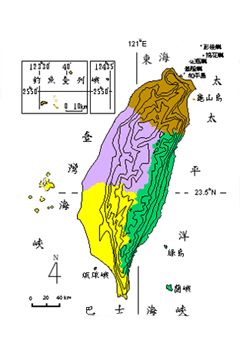The Communication Geography of Taiwan

Relevant Websites
- Taiwan Railway Website Museum
- Taiwan Railway Yearbook
- Institute of Transportation, MOTC
- Central Weather Bureau
- Travel Guide Systems
- Travel in Taiwan(Washington State Taiwan Office)
Reference
- Wang, Huang, 1974: Jin-dai-yun-shu-xue, The Commercial Press in Taiwan,p. 528.
- Wang, Huang, 1976: Tai-wan-jiao-tong-gai-lun, The Commercial Press in Taiwan, p. 192.
- Chen, Guang-hua, 1982: Zhong-guo-de-jiao-tong-yun-shu-fa-zhan, Zhong-yang-wen-wu-gong-ying-she, p. 472.
- Ministry of Transportation and Communications, 1986: Jiao-tong-nian-jian, p. 983.
- Ministry of Transportation and Communications, 1986: Jiao-tong-tong-ji-nian-bao, p. 216.
As an East Asian crossroads, Taiwan started to build its modern transportation facilities in the late nineteenth century. Due to the more mountainous topography of the central and eastern parts of the island, traffic is more condensed in the west. All means of transportation are used-people travel by air, by sea, and overland by rail and highway.
A. Ground Transportation
a. The national railway
The Ching Dynasty began to build railways in Taiwan in 1887. Then imperial inspector Liu Ming-chwan established a track from Taipei to Keelung, and extended it to Hsinchu in 1893. After the Sino-Japanese War the Japanese continued railway construction, completing a 404-kilometer track from Keelung to Kaohsiung. Almost a century later in 1979, the entire railroad system in western Taiwan was electrified by the ROC government. And since the completion of the northern-link and southern-link railways in 1991, Taiwan has been equipped with a railroad system that makes a complete circuit of the island. As of 1997 this rail system was more than 2,400 kilometers long with 216 stations.
b. Urban rapid transit systems
Rapid transit systems are indispensable to modern cities. So far, the Taipei Rapid Transit System has opened its Mucha, Hsintien, Tamshui, Nankan, Chungho and Panchau-Tuchen lines. Other metropolitan areas--Kaohsiung, Taichung, Tainan, Hsinchu and Taoyuan--will have their rapid transit systems in place in the near future.
c. High-speed railways
In order to improve the quality of transportation in western Taiwan, the construction of a high-speed railway was begun in July 1999. With a total length of 340.2 kilometers, it will run from Taipei to Zuo-ying in Kaohsiung. The whole line is expected to open in 2005.
d. Highways and freeways
In 1875, the imperial commisioner Shen Bao-jen opened up three major highways in the north, middle and south, setting the foundation for Taiwan's highway development. During Japanese colonial times, the number of highways was increased with the assistance of Japanese sappers. After World War II, the Taiwan Highway Bureau was established in August 1946: it has so far built more than 7,000 kilometers of highways. The Sun Yat-sen Freeway, vital to north-south traffic, was also inaugurated in 1978. With a total length of 20,185 kilometers (in 1997), Taiwan's highways can be classified into the following five types: national highways (2.7%), provincial highways (21.4%), county highways (12.2%), township highways (61.8%), and special highways (1.9%).
B. Sea Transportation
Taiwan's trade is mainly by sea. There are four international harbors: in Kaohsiung, Keelung, Taichung, and Hualien. The average volume of container cargo passing through these harbors per day is about 1.1 million tons. In terms of total container cargo, Kaohsiung is the fourth largest harbor in the world.
C. Air Transportation
a. Domestic flights
Taiwan's domestic air transportation started to develop after the ROC government moved to the island. The total number of passengers grew from 3.9 million in 1978 to 18.69 million in 1997, with an average growth rate of 8.6%. Located in major cities and also on the outlying islets, domestic airports handle 50 thousand passengers and 2,400 tons of freight on average every day.
b. International flights
ROC authorities have been working to open up international routes since 1966. Chiang Kai-shek International Airport commenced operations in 1979. There were only 30,000 flights in that year, but since 1987, when more carriers were allowed to join the market and ROC citizens were permitted to visit Mainland China, the number has increased to 110,000 (as of 2000). The number of international passengers has also increased from the initial 3 million to 18 million. And the volume of freight has expanded from the original 0.19 million tons to 1.2 million tons.
The business in Kaohsiung-based Hsiao-kang airport is also prospering in the same way. From 1991 to 1999, the number of international passengers grew from one million to 2.65 million, the number of flights from 6,000 to 22,000, and the volume of freight from 35,000 tons to 133,000 tons.